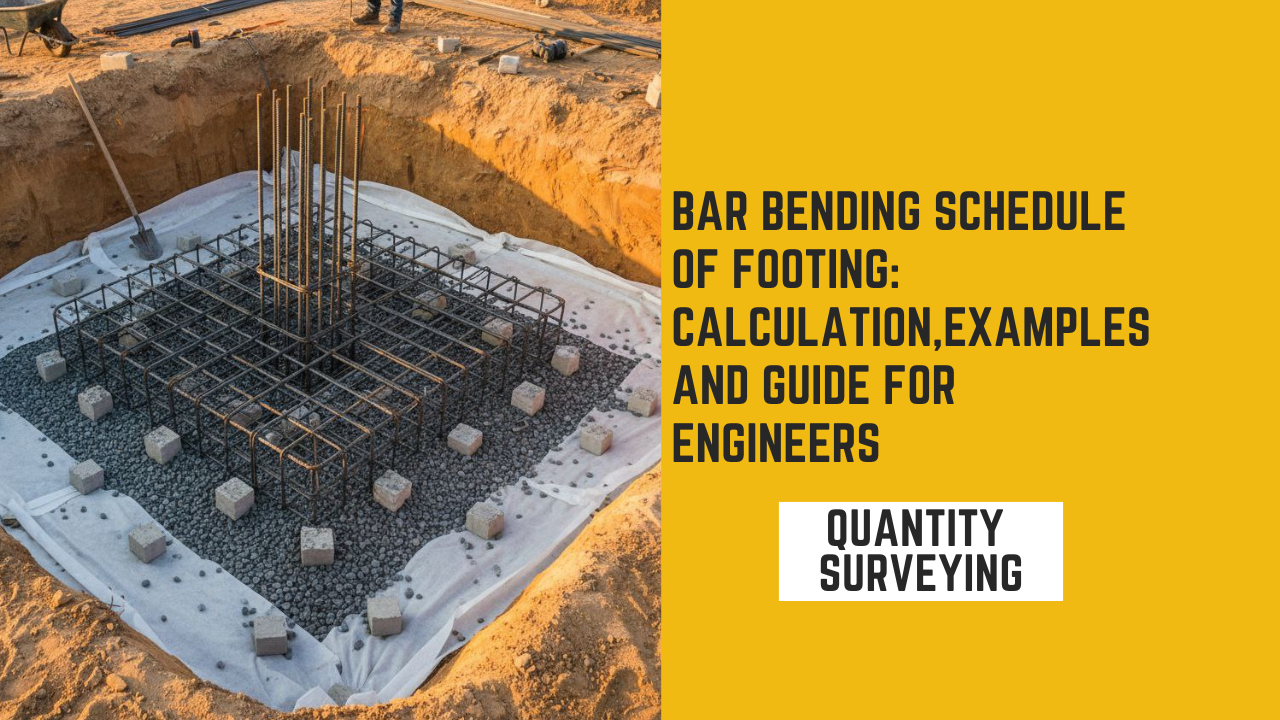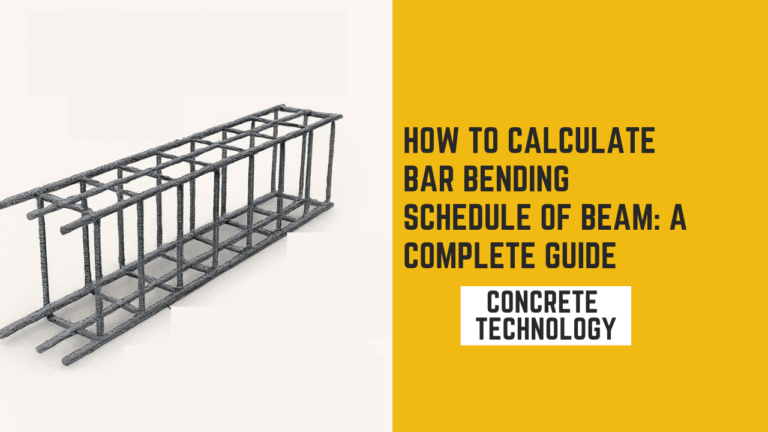Bar Bending Schedule Of footing: Calculation, example, and Complete Guide 2025

Introduction
In reinforced concrete construction, footings are the foundation elements that transfer loads from columns and walls to the soil safely. As footings carry heavy axial loads, their reinforcement design is critical for structural safety. To execute reinforcement work accurately and economically on-site, engineers prepare a Bar Bending Schedule of footings.
This article explains everything about the bar bending schedule of footing, including the step-by-step calculation process, examples with different footing types, and best practices for site execution.
What is a Bar Bending Schedule (BBS)?
A Bar Bending Schedule (BBS) is a systematic tabular representation of reinforcement details used in reinforced concrete (RC) structures. It provides essential information such as
- Type of Bar (main reinforcement, distribution bars, dowels, hooks, etc.)
- Bar diameter
- Number of bars
- Length of bars
- Shape and bending details
- Total length of reinforcement
- Total weight of reinforcement
BBS is prepared according to design drawings and codes (IS 456:2000, IS 2502:1963, BS 8666:2020, or ACI 315).
Importance of BBS in Footings
1. Accurate Steel Quantity Estimation – Helps avoid shortage or surplus of reinforcement
2. Cost Efficiency – Optimizes steel usage and reduces wastage
3. Ease of Site Work—Provides a clear plan for cutting, bending, and placing bars.
4. Better Supervision – Ensures reinforcement complies with design codes
5. Billing and Auditing – Useful for contractors and consultants in payment verification.
Types of Reinforcement in Footings
Footings generally include the following reinforcement types:
1. Main Reinforcement (Bottom Bars):
- Provided in both directions (X & Y).
- Designed to resist bending moments
- Usually larger in diameter (12 mm, 16 mm, 20 mm).
2. Distribution Bars (Top Bars, if required):
- Sometimes provided in certain footings for crack control
- Small-diameter compared to main bars
3. Dowels:
- Vertical bars connecting columns to footings.
- Extend from footing into the column for proper anchorage
4. Stirrups or Chairs (if needed):
- Used to maintain spacing between reinforcement layers.
General Formula for BBS
Cutting Length of Straight Bar:
L=Clear Span–2×Cover+Anchorage Length (if any)
Hook Length (90° bend): 9ϕ
Hook Length (135° bend): 16ϕ
Development Length (Ld):
Ld=(ϕ×σs)/(4×τbd)
Weight of Bar (kg/m):
W = (d^2}/{162}
Where:
ϕ = diameter of bar (mm)
σs = stress in steel
τbd = bond stress
Example 1: Bar Bending Schedule of Square Footing
Given Data:
- Size of footing = 2 m x 2 m x 0.3 m (thickness)
- Clear cover = 50 mm
- Main reinforcement = 12 mm dia @150 c/c both ways (bottom)
- Dowels = 16 mm dia., 9 bars, 600 mm height (column connection)
Step 1: Bottom Reinforcement
- Effective length = (2000 – 2×50) = 1900 mm
- Spacing = 150 mm
- Number of bars in one direction = (1900 / 150) + 1 = 13 bars
For both X and Y directions = 13 × 2 = 26 bars
Cutting length per bar = 2000 – 2×50 = 1900 mm
Total length = 26 × 1900 = 49.4 m
Weight per meter (12 mm bar) = (12² / 162) = 0.89 kg/m
Total weight = 49.4 × 0.89 = 43.9 kg
Step 2: Dowels
Number of dowels = 8 bars
Length = 600 mm + development length (say 40ϕ = 640 mm)
= 1240 mm ≈ 1.24 m each
Total length = 8 × 1.24 = 9.92 m
Weight per meter (16 mm bar) = (16² / 162) = 1.58 kg/m
Total weight = 9.92 × 1.58 = 15.7 kg
Step 3: Total Steel
- Bottom reinforcement = 43.9 kg
- Dowels = 15.7 kg
Total = 59.6 kg
Step 4: BBS Table
Bar Mark Type of Bar Dia (mm) No. of Bars Cutting Length (mm) Total Length (m) Weight (kg)
F1 Bottom Main Bars (X) 12 13 1900 24.7 22.0
F2 Bottom Main Bars (Y) 12 13 1900 24.7 22.0
F3 Dowels 16 8 1240 9.92 15.7
Total Steel = 59.6 kg
Example 2: Bar Bending Schedule of Rectangular Footing
Given Data:
- Footing size = 2.5 m × 1.5 m × 0.35 m
- Cover = 50 mm
- Main reinforcement = 16 mm dia @ 200 mm c/c along longer span (2.5 m)
- Distribution reinforcement = 12 mm dia @ 150 mm c/c along shorter span (1.5 m)
- Dowels = 16 mm dia, 6 bars, 600 mm height
Step 1: Main Reinforcement (Longer Side)
- Effective length = 2500 – 2×50 = 2400 mm
- Spacing = 200 mm
- Number of bars = (1500 – 2×50)/200 + 1 = (1400/200) +1 = 8 bars
Cutting length = 2400 mm = 2.4 m
Total length = 8 × 2.4 = 19.2 m
Weight = 19.2 × (16²/162) = 19.2 × 1.58 = 30.4 kg
Step 2: Distribution Reinforcement (Shorter Side)
- Effective length = 1500 – 2×50 = 1400 mm
- Spacing = 150 mm
- Number of bars = (2400/150) + 1 = 17 bars
Cutting length = 1400 mm = 1.4 m
Total length = 17 × 1.4 = 23.8 m
Weight = 23.8 × (12²/162) = 23.8 × 0.89 = 21.2 kg
Step 3: Dowels
- Length = 600 + 640 = 1240 mm = 1.24 m
- Total = 6 × 1.24 = 7.44 m
- Weight = 7.44 × 1.58 = 11.7 kg
Step 4: Total Steel
- Main = 30.4 kg
- Distribution = 21.2 kg
- Dowels = 11.7 kg
Total = 63.3 kg
Step 5: Final BBS Table
Step 5: Final BBS Table
Bar Mark Type of Bar Dia (mm) No. of Bars Cutting Length (mm) Total Length (m) Weight (kg)
F1 Main Reinforcement 16 8 2400 19.2 30.4
F2 Distribution Bars 12 17 1400 23.8 21.2
F3 Dowels 16 6 1240 7.44 11.7
Total = 63.3 kg
Software Tools for BBS of Footings
Preparing BBS manually is time-consuming. Engineers often use:
- MS Excel/Google Sheets—For customized BBS templates.
- Autocad add-ons—for extracting bar lengths automatically
- ETABS, STAAD PRO, TEKLA, REVIT—for structural design and reinforcement scheduling.
These tools improve accuracy and save time in complex projects.
Practical Tips for Footing BBS
- Deduct clear cover while calculating bar lengths.
- Add proper anchorage or bend length for dowels
- Maintain bar spacing as per IS 456:2000 or BS 8110
- Use chairs or spacers to ensure cover thickness.
- Always cross-check bar diameters to avoid mistakes during procurement.
Conclusion
The bar bending schedule (BBS) of footing is an essential part of construction planning and execution. It ensures accurate steel quantity, reduces wastage, and improves construction quality. By calculating reinforcement for bottom bars, distribution bars, and dowels systematically, engineers can prepare reliable BBS tables for both square and rectangular footings.
Whether calculated manually or generated using software, a proper BBS of footing bridges the gap between design and fieldwork. For contractors, consultants, and engineers, mastering BBS preparation is a key skill for efficient project management and cost control.






